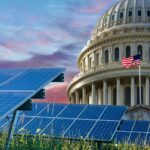- Resources
- Inflation Reduction Act Activation Guide: Building Energy Efficiency
Resources
Inflation Reduction Act Activation Guide: Building Energy Efficiency
Published: April 25, 2023 by Giada Mannino
Companies with high energy footprints are most likely to benefit from the IRA’s credits and deductions for energy saving building technologies, but any company that owns or has a long-term lease for a commercial building has an opportunity to benefit from the IRA.
Produced by EDF in collaboration with Deloitte.

